JCU LB5230: Risk Assessment Report - Woolworths Financial Audit
VerifiedAdded on 2023/06/03
|11
|2756
|177
Report
AI Summary
This report is a comprehensive risk assessment of Woolworths Limited, prepared as part of an audit plan. It begins with an introduction outlining the context of risk management in today's business environment and a brief overview of Woolworths. The report then identifies and analyzes the significant risks faced by the company, including strategic, compliance, financial, operational, and reputational risks. It details analytical procedures used in the audit process and highlights the significant audit risks, such as going concern. The report also discusses the audit risk model, significant inherent risks (inventories, intangibles, fixed assets, and foreign exchange transactions), and control risks (corporate governance, independent directors, and the audit and risk committee). The impact of audit testing and the implications of inherent and control risks for audit planning are also addressed. The report references relevant auditing standards and concludes by emphasizing the importance of effective risk assessment in the audit process.
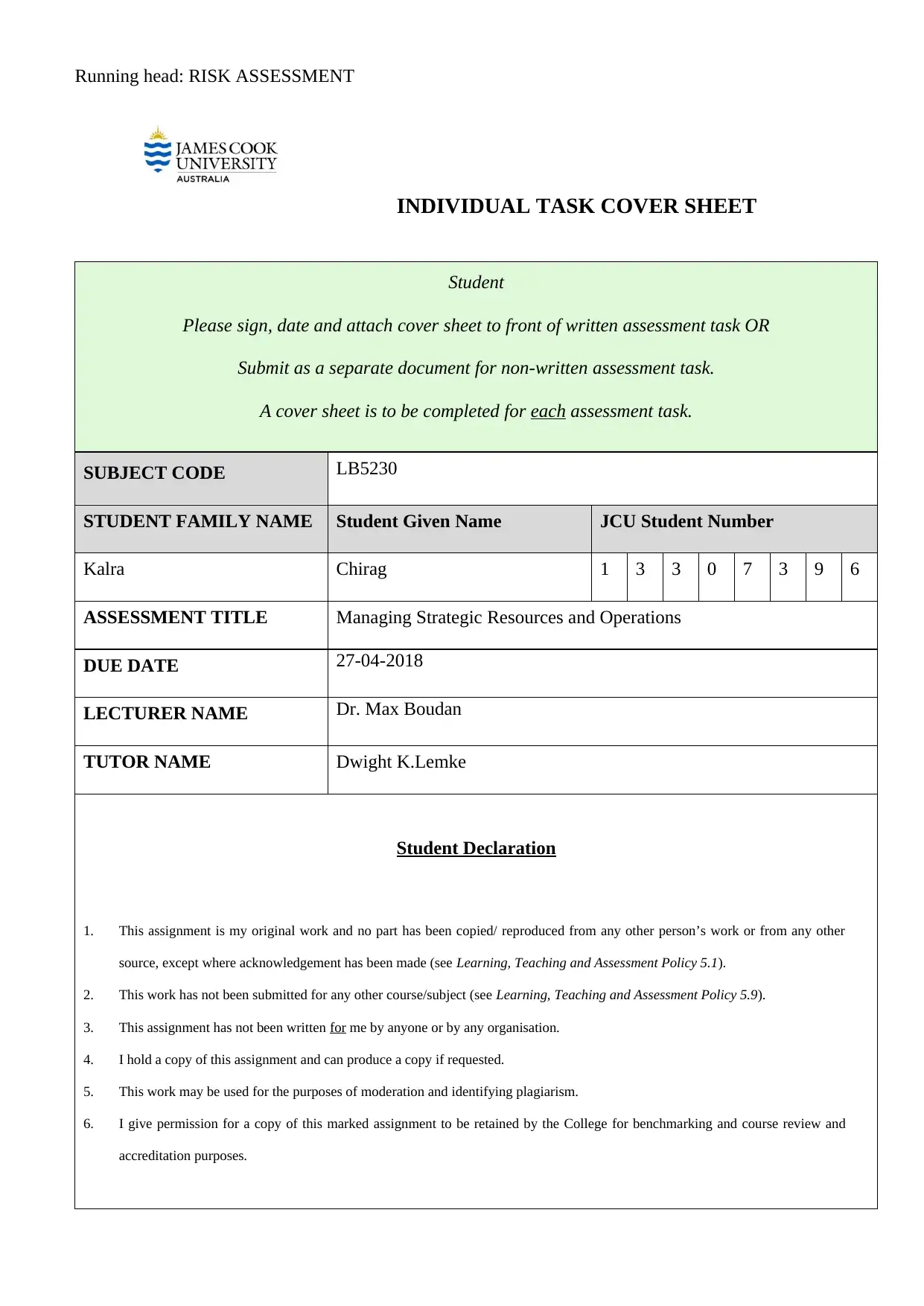
Running head: RISK ASSESSMENT
INDIVIDUAL TASK COVER SHEET
Student
Please sign, date and attach cover sheet to front of written assessment task OR
Submit as a separate document for non-written assessment task.
A cover sheet is to be completed for each assessment task.
SUBJECT CODE LB5230
STUDENT FAMILY NAME Student Given Name JCU Student Number
Kalra Chirag 1 3 3 0 7 3 9 6
ASSESSMENT TITLE Managing Strategic Resources and Operations
DUE DATE 27-04-2018
LECTURER NAME Dr. Max Boudan
TUTOR NAME Dwight K.Lemke
Student Declaration
1. This assignment is my original work and no part has been copied/ reproduced from any other person’s work or from any other
source, except where acknowledgement has been made (see Learning, Teaching and Assessment Policy 5.1).
2. This work has not been submitted for any other course/subject (see Learning, Teaching and Assessment Policy 5.9).
3. This assignment has not been written for me by anyone or by any organisation.
4. I hold a copy of this assignment and can produce a copy if requested.
5. This work may be used for the purposes of moderation and identifying plagiarism.
6. I give permission for a copy of this marked assignment to be retained by the College for benchmarking and course review and
accreditation purposes.
INDIVIDUAL TASK COVER SHEET
Student
Please sign, date and attach cover sheet to front of written assessment task OR
Submit as a separate document for non-written assessment task.
A cover sheet is to be completed for each assessment task.
SUBJECT CODE LB5230
STUDENT FAMILY NAME Student Given Name JCU Student Number
Kalra Chirag 1 3 3 0 7 3 9 6
ASSESSMENT TITLE Managing Strategic Resources and Operations
DUE DATE 27-04-2018
LECTURER NAME Dr. Max Boudan
TUTOR NAME Dwight K.Lemke
Student Declaration
1. This assignment is my original work and no part has been copied/ reproduced from any other person’s work or from any other
source, except where acknowledgement has been made (see Learning, Teaching and Assessment Policy 5.1).
2. This work has not been submitted for any other course/subject (see Learning, Teaching and Assessment Policy 5.9).
3. This assignment has not been written for me by anyone or by any organisation.
4. I hold a copy of this assignment and can produce a copy if requested.
5. This work may be used for the purposes of moderation and identifying plagiarism.
6. I give permission for a copy of this marked assignment to be retained by the College for benchmarking and course review and
accreditation purposes.
Paraphrase This Document
Need a fresh take? Get an instant paraphrase of this document with our AI Paraphraser

1RISK ASSESSMENT
Learning, Teaching and Assessment Policy 5.1. A student who submits work containing plagiarised material for assessment
will be subject to the provisions of the Student Academic Misconduct Requirements.
Note definition of plagiarism and self-plagiarism in Learning, Teaching and Assessment Policy:
Plagiarism: reproduction without acknowledgement of another person’s words, work or expressed thoughts from any source. The
definition of words, works and thoughts includes such representations as diagrams, drawings, sketches, pictures, objects, text, lecture hand-
outs, artistic works and other such expressions of ideas, but hereafter the term ‘work’ is used to embrace all of these. Plagiarism comprises
not only direct copying of aspects of another person’s work but also the reproduction, even if slightly rewritten or adapted, of someone
else’s ideas. In both cases, someone else’s work is presented as the student’s own. Under the Australian Copyright Act 1968 a copyright
owner can take legal action in the courts against a party who has infringed their copyright.
Self-Plagiarism: theuse of one’s own previously assessed material being resubmitted without acknowledgement or citing of the original.
Student Signature
Chirag KalraSubmission date 27 / 04/ 2018
Learning, Teaching and Assessment Policy 5.1. A student who submits work containing plagiarised material for assessment
will be subject to the provisions of the Student Academic Misconduct Requirements.
Note definition of plagiarism and self-plagiarism in Learning, Teaching and Assessment Policy:
Plagiarism: reproduction without acknowledgement of another person’s words, work or expressed thoughts from any source. The
definition of words, works and thoughts includes such representations as diagrams, drawings, sketches, pictures, objects, text, lecture hand-
outs, artistic works and other such expressions of ideas, but hereafter the term ‘work’ is used to embrace all of these. Plagiarism comprises
not only direct copying of aspects of another person’s work but also the reproduction, even if slightly rewritten or adapted, of someone
else’s ideas. In both cases, someone else’s work is presented as the student’s own. Under the Australian Copyright Act 1968 a copyright
owner can take legal action in the courts against a party who has infringed their copyright.
Self-Plagiarism: theuse of one’s own previously assessed material being resubmitted without acknowledgement or citing of the original.
Student Signature
Chirag KalraSubmission date 27 / 04/ 2018
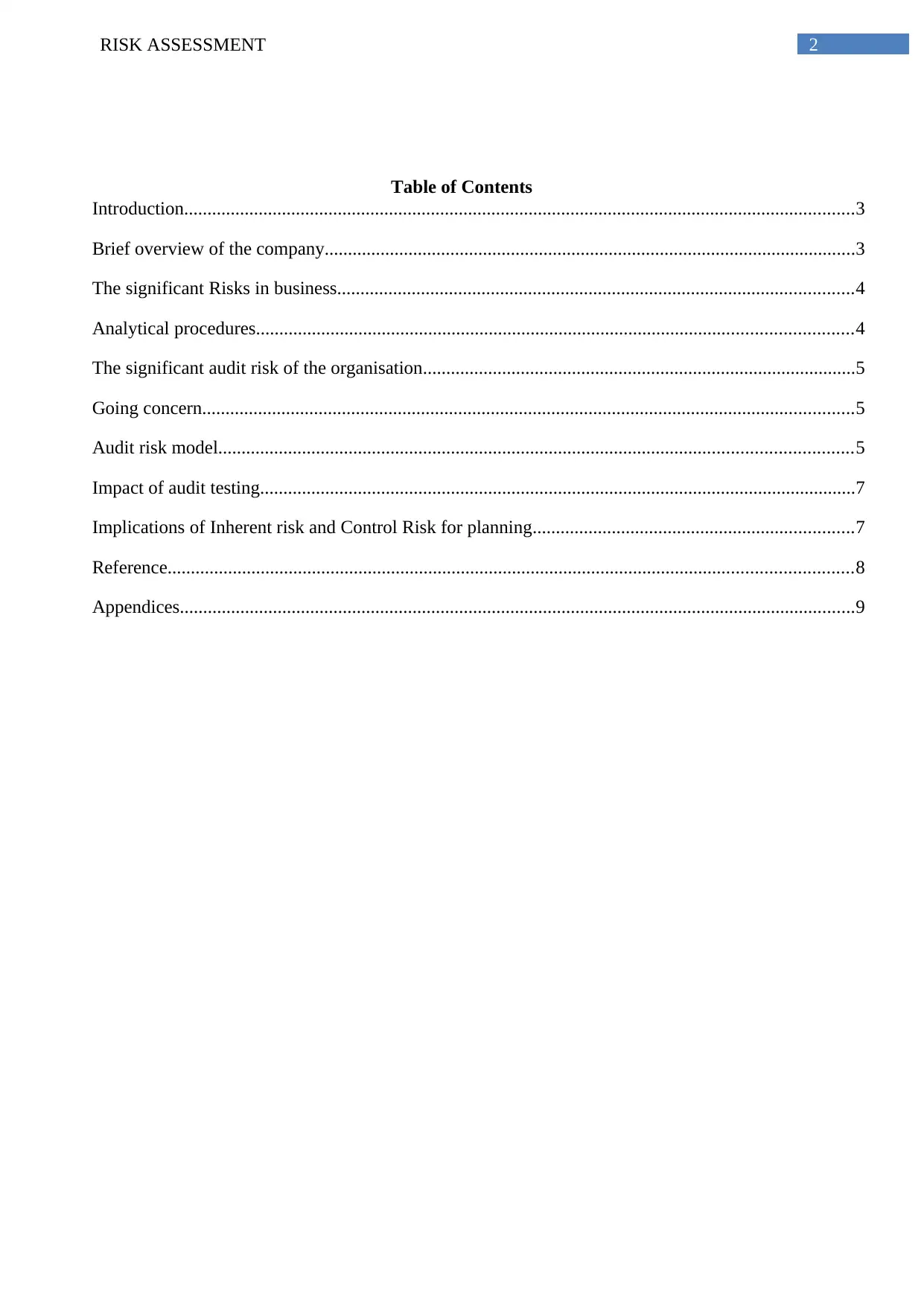
2RISK ASSESSMENT
Table of Contents
Introduction................................................................................................................................................3
Brief overview of the company..................................................................................................................3
The significant Risks in business...............................................................................................................4
Analytical procedures................................................................................................................................4
The significant audit risk of the organisation.............................................................................................5
Going concern............................................................................................................................................5
Audit risk model........................................................................................................................................5
Impact of audit testing................................................................................................................................7
Implications of Inherent risk and Control Risk for planning.....................................................................7
Reference...................................................................................................................................................8
Appendices.................................................................................................................................................9
Table of Contents
Introduction................................................................................................................................................3
Brief overview of the company..................................................................................................................3
The significant Risks in business...............................................................................................................4
Analytical procedures................................................................................................................................4
The significant audit risk of the organisation.............................................................................................5
Going concern............................................................................................................................................5
Audit risk model........................................................................................................................................5
Impact of audit testing................................................................................................................................7
Implications of Inherent risk and Control Risk for planning.....................................................................7
Reference...................................................................................................................................................8
Appendices.................................................................................................................................................9
⊘ This is a preview!⊘
Do you want full access?
Subscribe today to unlock all pages.

Trusted by 1+ million students worldwide
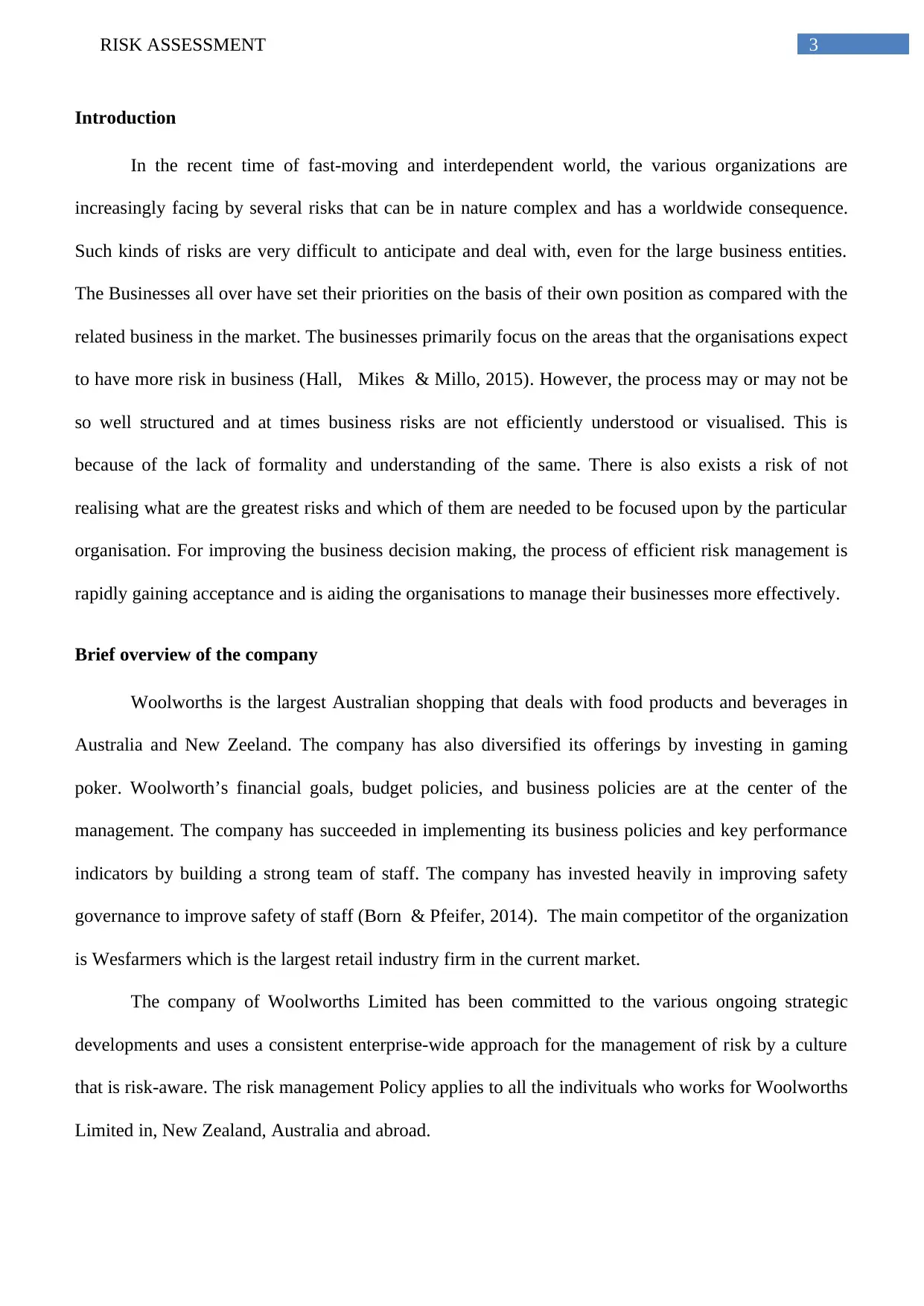
3RISK ASSESSMENT
Introduction
In the recent time of fast-moving and interdependent world, the various organizations are
increasingly facing by several risks that can be in nature complex and has a worldwide consequence.
Such kinds of risks are very difficult to anticipate and deal with, even for the large business entities.
The Businesses all over have set their priorities on the basis of their own position as compared with the
related business in the market. The businesses primarily focus on the areas that the organisations expect
to have more risk in business (Hall, Mikes & Millo, 2015). However, the process may or may not be
so well structured and at times business risks are not efficiently understood or visualised. This is
because of the lack of formality and understanding of the same. There is also exists a risk of not
realising what are the greatest risks and which of them are needed to be focused upon by the particular
organisation. For improving the business decision making, the process of efficient risk management is
rapidly gaining acceptance and is aiding the organisations to manage their businesses more effectively.
Brief overview of the company
Woolworths is the largest Australian shopping that deals with food products and beverages in
Australia and New Zeeland. The company has also diversified its offerings by investing in gaming
poker. Woolworth’s financial goals, budget policies, and business policies are at the center of the
management. The company has succeeded in implementing its business policies and key performance
indicators by building a strong team of staff. The company has invested heavily in improving safety
governance to improve safety of staff (Born & Pfeifer, 2014). The main competitor of the organization
is Wesfarmers which is the largest retail industry firm in the current market.
The company of Woolworths Limited has been committed to the various ongoing strategic
developments and uses a consistent enterprise-wide approach for the management of risk by a culture
that is risk-aware. The risk management Policy applies to all the indivituals who works for Woolworths
Limited in, New Zealand, Australia and abroad.
Introduction
In the recent time of fast-moving and interdependent world, the various organizations are
increasingly facing by several risks that can be in nature complex and has a worldwide consequence.
Such kinds of risks are very difficult to anticipate and deal with, even for the large business entities.
The Businesses all over have set their priorities on the basis of their own position as compared with the
related business in the market. The businesses primarily focus on the areas that the organisations expect
to have more risk in business (Hall, Mikes & Millo, 2015). However, the process may or may not be
so well structured and at times business risks are not efficiently understood or visualised. This is
because of the lack of formality and understanding of the same. There is also exists a risk of not
realising what are the greatest risks and which of them are needed to be focused upon by the particular
organisation. For improving the business decision making, the process of efficient risk management is
rapidly gaining acceptance and is aiding the organisations to manage their businesses more effectively.
Brief overview of the company
Woolworths is the largest Australian shopping that deals with food products and beverages in
Australia and New Zeeland. The company has also diversified its offerings by investing in gaming
poker. Woolworth’s financial goals, budget policies, and business policies are at the center of the
management. The company has succeeded in implementing its business policies and key performance
indicators by building a strong team of staff. The company has invested heavily in improving safety
governance to improve safety of staff (Born & Pfeifer, 2014). The main competitor of the organization
is Wesfarmers which is the largest retail industry firm in the current market.
The company of Woolworths Limited has been committed to the various ongoing strategic
developments and uses a consistent enterprise-wide approach for the management of risk by a culture
that is risk-aware. The risk management Policy applies to all the indivituals who works for Woolworths
Limited in, New Zealand, Australia and abroad.
Paraphrase This Document
Need a fresh take? Get an instant paraphrase of this document with our AI Paraphraser
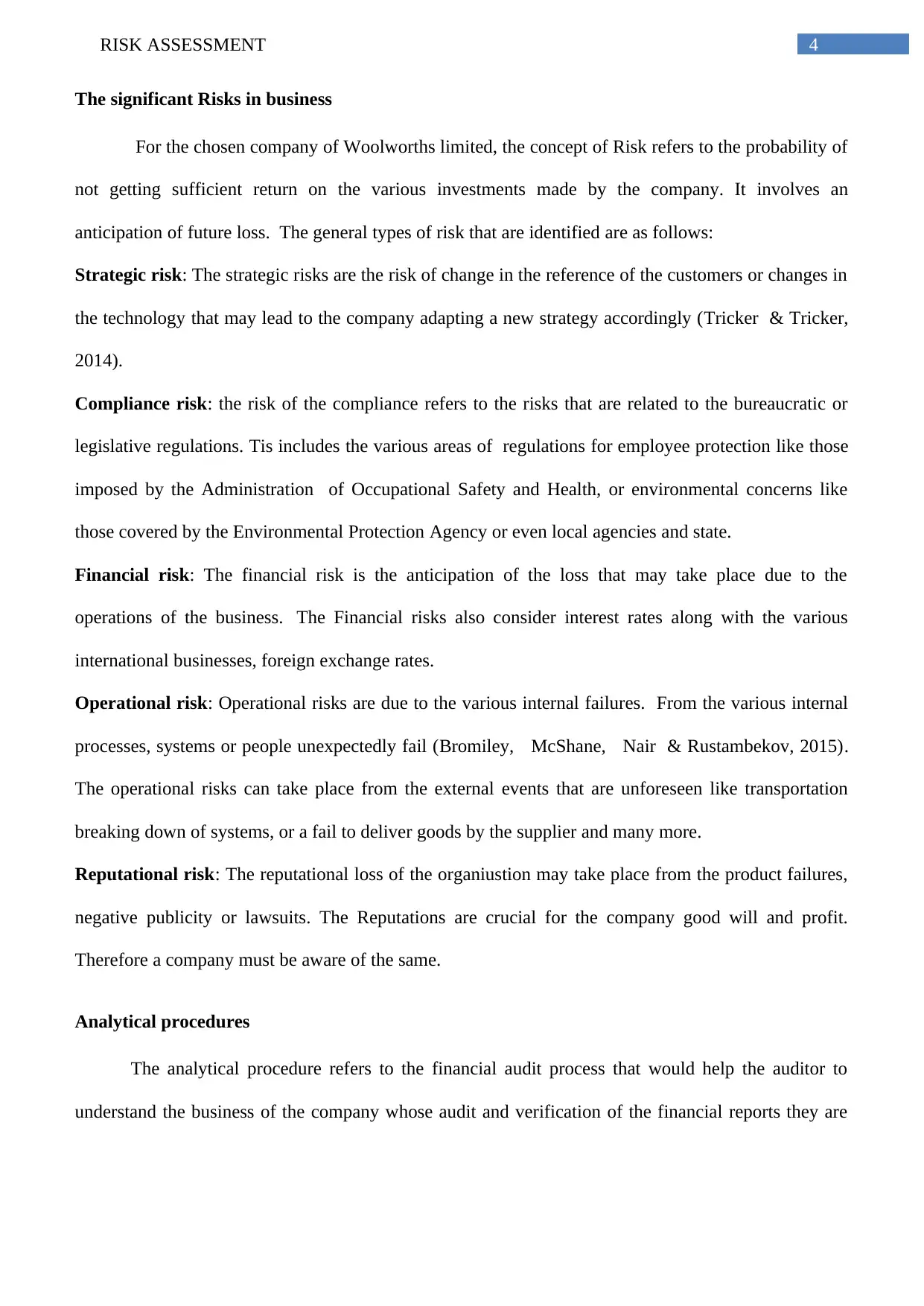
4RISK ASSESSMENT
The significant Risks in business
For the chosen company of Woolworths limited, the concept of Risk refers to the probability of
not getting sufficient return on the various investments made by the company. It involves an
anticipation of future loss. The general types of risk that are identified are as follows:
Strategic risk: The strategic risks are the risk of change in the reference of the customers or changes in
the technology that may lead to the company adapting a new strategy accordingly (Tricker & Tricker,
2014).
Compliance risk: the risk of the compliance refers to the risks that are related to the bureaucratic or
legislative regulations. Tis includes the various areas of regulations for employee protection like those
imposed by the Administration of Occupational Safety and Health, or environmental concerns like
those covered by the Environmental Protection Agency or even local agencies and state.
Financial risk: The financial risk is the anticipation of the loss that may take place due to the
operations of the business. The Financial risks also consider interest rates along with the various
international businesses, foreign exchange rates.
Operational risk: Operational risks are due to the various internal failures. From the various internal
processes, systems or people unexpectedly fail (Bromiley, McShane, Nair & Rustambekov, 2015).
The operational risks can take place from the external events that are unforeseen like transportation
breaking down of systems, or a fail to deliver goods by the supplier and many more.
Reputational risk: The reputational loss of the organiustion may take place from the product failures,
negative publicity or lawsuits. The Reputations are crucial for the company good will and profit.
Therefore a company must be aware of the same.
Analytical procedures
The analytical procedure refers to the financial audit process that would help the auditor to
understand the business of the company whose audit and verification of the financial reports they are
The significant Risks in business
For the chosen company of Woolworths limited, the concept of Risk refers to the probability of
not getting sufficient return on the various investments made by the company. It involves an
anticipation of future loss. The general types of risk that are identified are as follows:
Strategic risk: The strategic risks are the risk of change in the reference of the customers or changes in
the technology that may lead to the company adapting a new strategy accordingly (Tricker & Tricker,
2014).
Compliance risk: the risk of the compliance refers to the risks that are related to the bureaucratic or
legislative regulations. Tis includes the various areas of regulations for employee protection like those
imposed by the Administration of Occupational Safety and Health, or environmental concerns like
those covered by the Environmental Protection Agency or even local agencies and state.
Financial risk: The financial risk is the anticipation of the loss that may take place due to the
operations of the business. The Financial risks also consider interest rates along with the various
international businesses, foreign exchange rates.
Operational risk: Operational risks are due to the various internal failures. From the various internal
processes, systems or people unexpectedly fail (Bromiley, McShane, Nair & Rustambekov, 2015).
The operational risks can take place from the external events that are unforeseen like transportation
breaking down of systems, or a fail to deliver goods by the supplier and many more.
Reputational risk: The reputational loss of the organiustion may take place from the product failures,
negative publicity or lawsuits. The Reputations are crucial for the company good will and profit.
Therefore a company must be aware of the same.
Analytical procedures
The analytical procedure refers to the financial audit process that would help the auditor to
understand the business of the company whose audit and verification of the financial reports they are
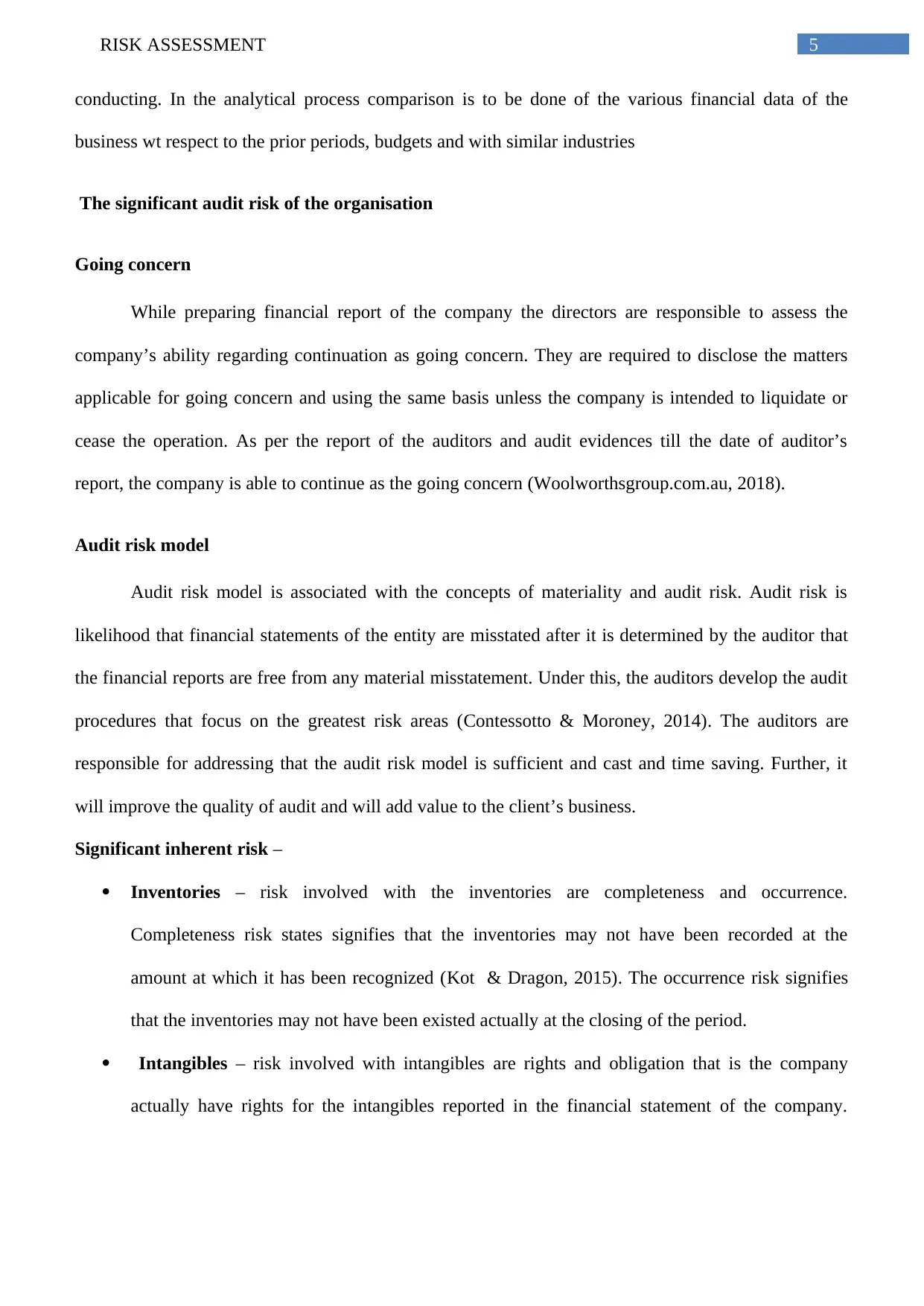
5RISK ASSESSMENT
conducting. In the analytical process comparison is to be done of the various financial data of the
business wt respect to the prior periods, budgets and with similar industries
The significant audit risk of the organisation
Going concern
While preparing financial report of the company the directors are responsible to assess the
company’s ability regarding continuation as going concern. They are required to disclose the matters
applicable for going concern and using the same basis unless the company is intended to liquidate or
cease the operation. As per the report of the auditors and audit evidences till the date of auditor’s
report, the company is able to continue as the going concern (Woolworthsgroup.com.au, 2018).
Audit risk model
Audit risk model is associated with the concepts of materiality and audit risk. Audit risk is
likelihood that financial statements of the entity are misstated after it is determined by the auditor that
the financial reports are free from any material misstatement. Under this, the auditors develop the audit
procedures that focus on the greatest risk areas (Contessotto & Moroney, 2014). The auditors are
responsible for addressing that the audit risk model is sufficient and cast and time saving. Further, it
will improve the quality of audit and will add value to the client’s business.
Significant inherent risk –
Inventories – risk involved with the inventories are completeness and occurrence.
Completeness risk states signifies that the inventories may not have been recorded at the
amount at which it has been recognized (Kot & Dragon, 2015). The occurrence risk signifies
that the inventories may not have been existed actually at the closing of the period.
Intangibles – risk involved with intangibles are rights and obligation that is the company
actually have rights for the intangibles reported in the financial statement of the company.
conducting. In the analytical process comparison is to be done of the various financial data of the
business wt respect to the prior periods, budgets and with similar industries
The significant audit risk of the organisation
Going concern
While preparing financial report of the company the directors are responsible to assess the
company’s ability regarding continuation as going concern. They are required to disclose the matters
applicable for going concern and using the same basis unless the company is intended to liquidate or
cease the operation. As per the report of the auditors and audit evidences till the date of auditor’s
report, the company is able to continue as the going concern (Woolworthsgroup.com.au, 2018).
Audit risk model
Audit risk model is associated with the concepts of materiality and audit risk. Audit risk is
likelihood that financial statements of the entity are misstated after it is determined by the auditor that
the financial reports are free from any material misstatement. Under this, the auditors develop the audit
procedures that focus on the greatest risk areas (Contessotto & Moroney, 2014). The auditors are
responsible for addressing that the audit risk model is sufficient and cast and time saving. Further, it
will improve the quality of audit and will add value to the client’s business.
Significant inherent risk –
Inventories – risk involved with the inventories are completeness and occurrence.
Completeness risk states signifies that the inventories may not have been recorded at the
amount at which it has been recognized (Kot & Dragon, 2015). The occurrence risk signifies
that the inventories may not have been existed actually at the closing of the period.
Intangibles – risk involved with intangibles are rights and obligation that is the company
actually have rights for the intangibles reported in the financial statement of the company.
⊘ This is a preview!⊘
Do you want full access?
Subscribe today to unlock all pages.

Trusted by 1+ million students worldwide
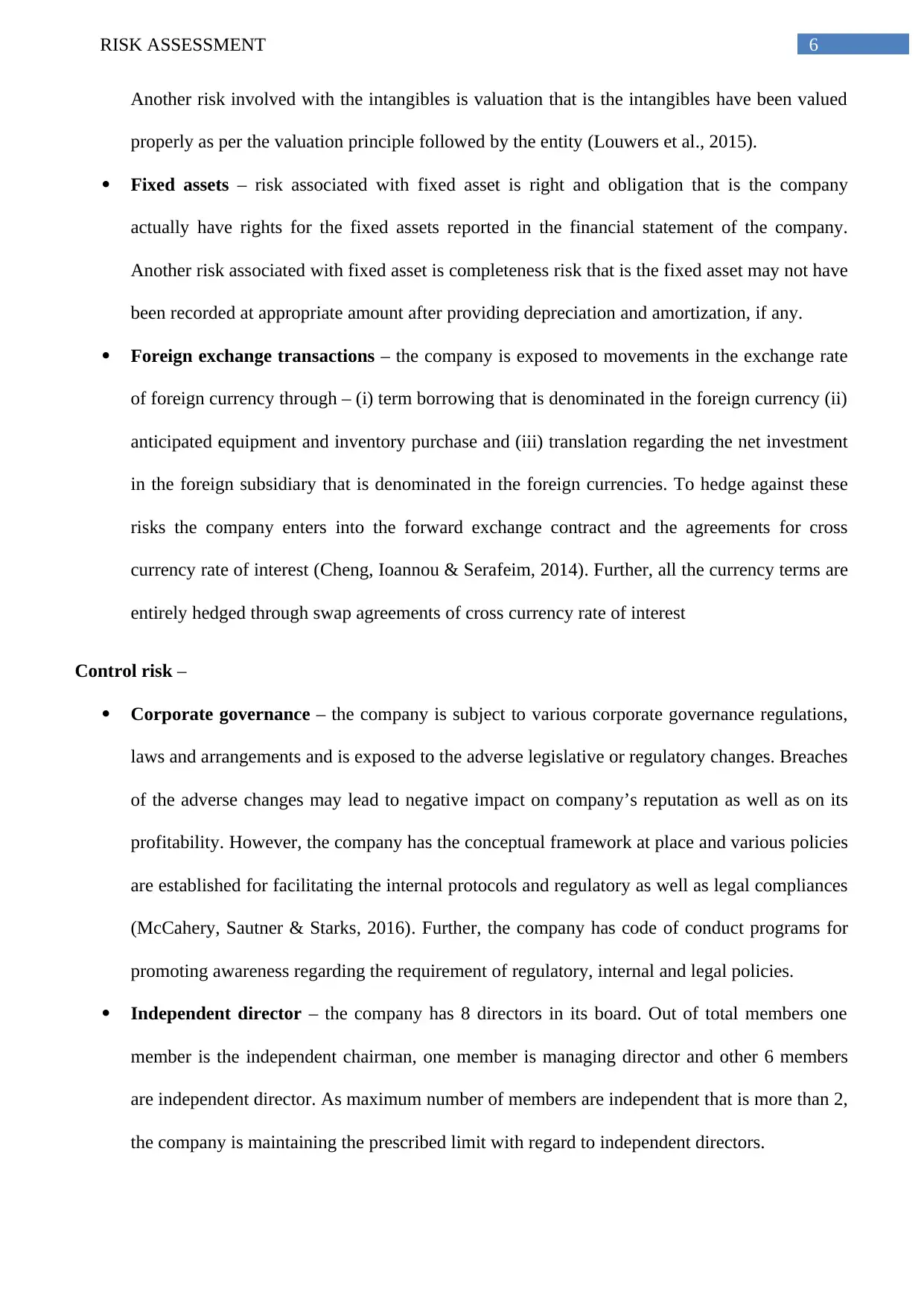
6RISK ASSESSMENT
Another risk involved with the intangibles is valuation that is the intangibles have been valued
properly as per the valuation principle followed by the entity (Louwers et al., 2015).
Fixed assets – risk associated with fixed asset is right and obligation that is the company
actually have rights for the fixed assets reported in the financial statement of the company.
Another risk associated with fixed asset is completeness risk that is the fixed asset may not have
been recorded at appropriate amount after providing depreciation and amortization, if any.
Foreign exchange transactions – the company is exposed to movements in the exchange rate
of foreign currency through – (i) term borrowing that is denominated in the foreign currency (ii)
anticipated equipment and inventory purchase and (iii) translation regarding the net investment
in the foreign subsidiary that is denominated in the foreign currencies. To hedge against these
risks the company enters into the forward exchange contract and the agreements for cross
currency rate of interest (Cheng, Ioannou & Serafeim, 2014). Further, all the currency terms are
entirely hedged through swap agreements of cross currency rate of interest
Control risk –
Corporate governance – the company is subject to various corporate governance regulations,
laws and arrangements and is exposed to the adverse legislative or regulatory changes. Breaches
of the adverse changes may lead to negative impact on company’s reputation as well as on its
profitability. However, the company has the conceptual framework at place and various policies
are established for facilitating the internal protocols and regulatory as well as legal compliances
(McCahery, Sautner & Starks, 2016). Further, the company has code of conduct programs for
promoting awareness regarding the requirement of regulatory, internal and legal policies.
Independent director – the company has 8 directors in its board. Out of total members one
member is the independent chairman, one member is managing director and other 6 members
are independent director. As maximum number of members are independent that is more than 2,
the company is maintaining the prescribed limit with regard to independent directors.
Another risk involved with the intangibles is valuation that is the intangibles have been valued
properly as per the valuation principle followed by the entity (Louwers et al., 2015).
Fixed assets – risk associated with fixed asset is right and obligation that is the company
actually have rights for the fixed assets reported in the financial statement of the company.
Another risk associated with fixed asset is completeness risk that is the fixed asset may not have
been recorded at appropriate amount after providing depreciation and amortization, if any.
Foreign exchange transactions – the company is exposed to movements in the exchange rate
of foreign currency through – (i) term borrowing that is denominated in the foreign currency (ii)
anticipated equipment and inventory purchase and (iii) translation regarding the net investment
in the foreign subsidiary that is denominated in the foreign currencies. To hedge against these
risks the company enters into the forward exchange contract and the agreements for cross
currency rate of interest (Cheng, Ioannou & Serafeim, 2014). Further, all the currency terms are
entirely hedged through swap agreements of cross currency rate of interest
Control risk –
Corporate governance – the company is subject to various corporate governance regulations,
laws and arrangements and is exposed to the adverse legislative or regulatory changes. Breaches
of the adverse changes may lead to negative impact on company’s reputation as well as on its
profitability. However, the company has the conceptual framework at place and various policies
are established for facilitating the internal protocols and regulatory as well as legal compliances
(McCahery, Sautner & Starks, 2016). Further, the company has code of conduct programs for
promoting awareness regarding the requirement of regulatory, internal and legal policies.
Independent director – the company has 8 directors in its board. Out of total members one
member is the independent chairman, one member is managing director and other 6 members
are independent director. As maximum number of members are independent that is more than 2,
the company is maintaining the prescribed limit with regard to independent directors.
Paraphrase This Document
Need a fresh take? Get an instant paraphrase of this document with our AI Paraphraser
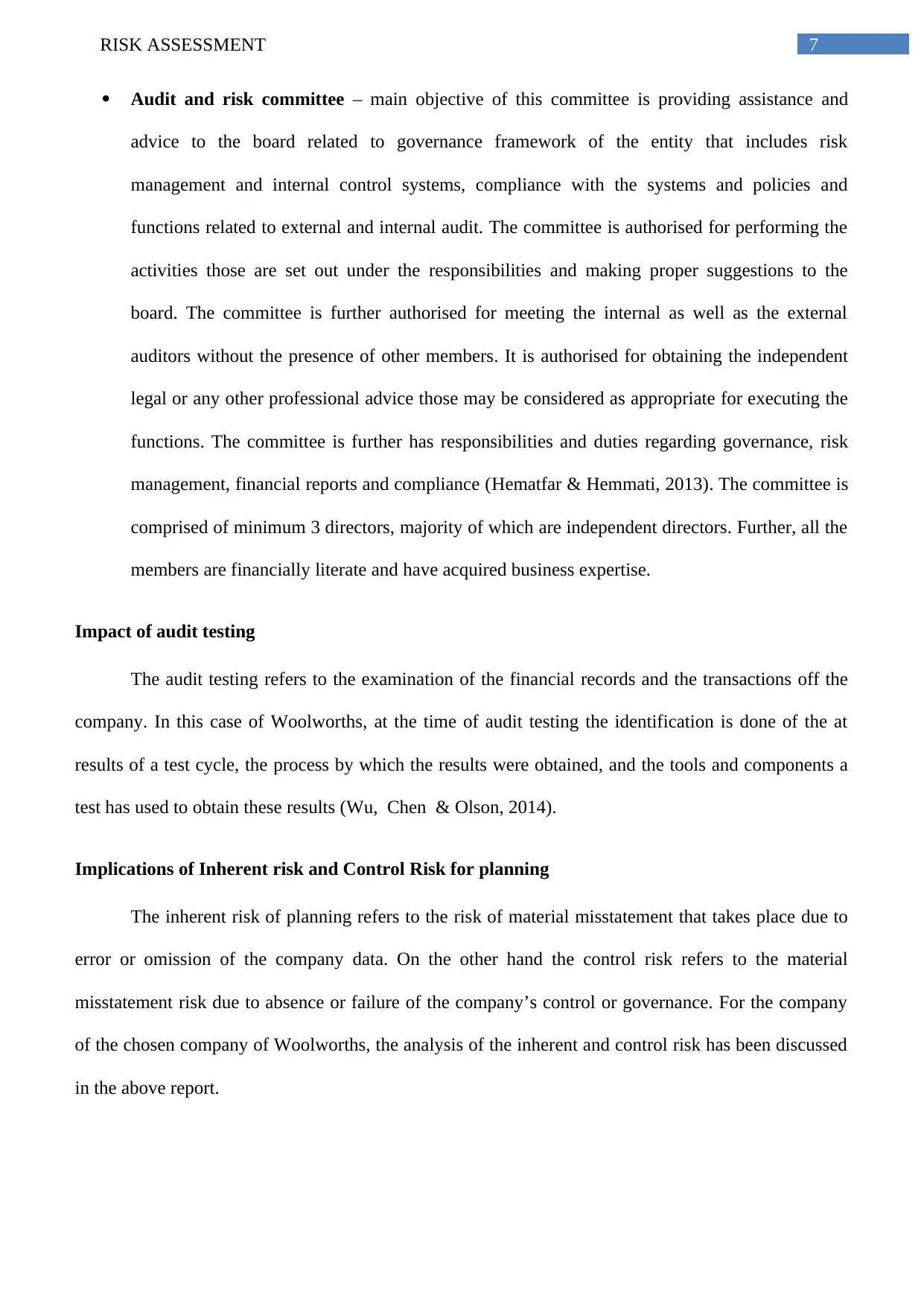
7RISK ASSESSMENT
Audit and risk committee – main objective of this committee is providing assistance and
advice to the board related to governance framework of the entity that includes risk
management and internal control systems, compliance with the systems and policies and
functions related to external and internal audit. The committee is authorised for performing the
activities those are set out under the responsibilities and making proper suggestions to the
board. The committee is further authorised for meeting the internal as well as the external
auditors without the presence of other members. It is authorised for obtaining the independent
legal or any other professional advice those may be considered as appropriate for executing the
functions. The committee is further has responsibilities and duties regarding governance, risk
management, financial reports and compliance (Hematfar & Hemmati, 2013). The committee is
comprised of minimum 3 directors, majority of which are independent directors. Further, all the
members are financially literate and have acquired business expertise.
Impact of audit testing
The audit testing refers to the examination of the financial records and the transactions off the
company. In this case of Woolworths, at the time of audit testing the identification is done of the at
results of a test cycle, the process by which the results were obtained, and the tools and components a
test has used to obtain these results (Wu, Chen & Olson, 2014).
Implications of Inherent risk and Control Risk for planning
The inherent risk of planning refers to the risk of material misstatement that takes place due to
error or omission of the company data. On the other hand the control risk refers to the material
misstatement risk due to absence or failure of the company’s control or governance. For the company
of the chosen company of Woolworths, the analysis of the inherent and control risk has been discussed
in the above report.
Audit and risk committee – main objective of this committee is providing assistance and
advice to the board related to governance framework of the entity that includes risk
management and internal control systems, compliance with the systems and policies and
functions related to external and internal audit. The committee is authorised for performing the
activities those are set out under the responsibilities and making proper suggestions to the
board. The committee is further authorised for meeting the internal as well as the external
auditors without the presence of other members. It is authorised for obtaining the independent
legal or any other professional advice those may be considered as appropriate for executing the
functions. The committee is further has responsibilities and duties regarding governance, risk
management, financial reports and compliance (Hematfar & Hemmati, 2013). The committee is
comprised of minimum 3 directors, majority of which are independent directors. Further, all the
members are financially literate and have acquired business expertise.
Impact of audit testing
The audit testing refers to the examination of the financial records and the transactions off the
company. In this case of Woolworths, at the time of audit testing the identification is done of the at
results of a test cycle, the process by which the results were obtained, and the tools and components a
test has used to obtain these results (Wu, Chen & Olson, 2014).
Implications of Inherent risk and Control Risk for planning
The inherent risk of planning refers to the risk of material misstatement that takes place due to
error or omission of the company data. On the other hand the control risk refers to the material
misstatement risk due to absence or failure of the company’s control or governance. For the company
of the chosen company of Woolworths, the analysis of the inherent and control risk has been discussed
in the above report.

8RISK ASSESSMENT
Reference
Born, B., & Pfeifer, J. (2014). Policy risk and the business cycle. Journal of Monetary Economics, 68,
68-85.
Bromiley, P., McShane, M., Nair, A., & Rustambekov, E. (2015). Enterprise risk management:
Review, critique, and research directions. Long range planning, 48(4), 265-276.
Cheng, B., Ioannou, I., & Serafeim, G. (2014). Corporate social responsibility and access to
finance. Strategic management journal, 35(1), 1-23.
Contessotto, C., & Moroney, R. (2014). The association between audit committee effectiveness and
audit risk. Accounting & Finance, 54(2), 393-418.
Hall, M., Mikes, A., & Millo, Y. (2015). How do risk managers become influential? A field study of
toolmaking in two financial institutions. Management Accounting Research, 26, 3-22.
Hematfar, M., & Hemmati, M. (2013). A comparison of risk-based and traditional auditing and their
effect on the quality of audit reports. International Research Journal of Applied and Basic
Sciences, 4(8), 2088-2091.
Kot, S., & Dragon, P. (2015). Business risk management in international corporations. Procedia
Economics and Finance, 27, 102-108.
Louwers, T. J., Ramsay, R. J., Sinason, D. H., Strawser, J. R., & Thibodeau, J. C. (2015). Auditing &
assurance services. McGraw-Hill Education.
McCahery, J.A., Sautner, Z. & Starks, L.T., (2016). Behind the scenes: The corporate governance
preferences of institutional investors. The Journal of Finance, 71(6), pp.2905-2932.
Tricker, B., & Tricker, G. (2014). Business Ethics: A stakeholder, governance and risk approach.
Routledge.
Woolworthsgroup.com.au. (2018). Retrieved 28 September 2018, from
https://www.woolworthsgroup.com.au/icms_docs/186100_audit-risk-management-and-
compliance-committee-charter.pdf
Reference
Born, B., & Pfeifer, J. (2014). Policy risk and the business cycle. Journal of Monetary Economics, 68,
68-85.
Bromiley, P., McShane, M., Nair, A., & Rustambekov, E. (2015). Enterprise risk management:
Review, critique, and research directions. Long range planning, 48(4), 265-276.
Cheng, B., Ioannou, I., & Serafeim, G. (2014). Corporate social responsibility and access to
finance. Strategic management journal, 35(1), 1-23.
Contessotto, C., & Moroney, R. (2014). The association between audit committee effectiveness and
audit risk. Accounting & Finance, 54(2), 393-418.
Hall, M., Mikes, A., & Millo, Y. (2015). How do risk managers become influential? A field study of
toolmaking in two financial institutions. Management Accounting Research, 26, 3-22.
Hematfar, M., & Hemmati, M. (2013). A comparison of risk-based and traditional auditing and their
effect on the quality of audit reports. International Research Journal of Applied and Basic
Sciences, 4(8), 2088-2091.
Kot, S., & Dragon, P. (2015). Business risk management in international corporations. Procedia
Economics and Finance, 27, 102-108.
Louwers, T. J., Ramsay, R. J., Sinason, D. H., Strawser, J. R., & Thibodeau, J. C. (2015). Auditing &
assurance services. McGraw-Hill Education.
McCahery, J.A., Sautner, Z. & Starks, L.T., (2016). Behind the scenes: The corporate governance
preferences of institutional investors. The Journal of Finance, 71(6), pp.2905-2932.
Tricker, B., & Tricker, G. (2014). Business Ethics: A stakeholder, governance and risk approach.
Routledge.
Woolworthsgroup.com.au. (2018). Retrieved 28 September 2018, from
https://www.woolworthsgroup.com.au/icms_docs/186100_audit-risk-management-and-
compliance-committee-charter.pdf
⊘ This is a preview!⊘
Do you want full access?
Subscribe today to unlock all pages.

Trusted by 1+ million students worldwide

9RISK ASSESSMENT
Wu, D. D., Chen, S. H., & Olson, D. L. (2014). Business intelligence in risk management: Some recent
progresses. Information Sciences, 256, 1-7.
Appendices
Balance sheet statement of Woolworths 2018
Statement of profit and loss of Woolworths 2018
Wu, D. D., Chen, S. H., & Olson, D. L. (2014). Business intelligence in risk management: Some recent
progresses. Information Sciences, 256, 1-7.
Appendices
Balance sheet statement of Woolworths 2018
Statement of profit and loss of Woolworths 2018
Paraphrase This Document
Need a fresh take? Get an instant paraphrase of this document with our AI Paraphraser
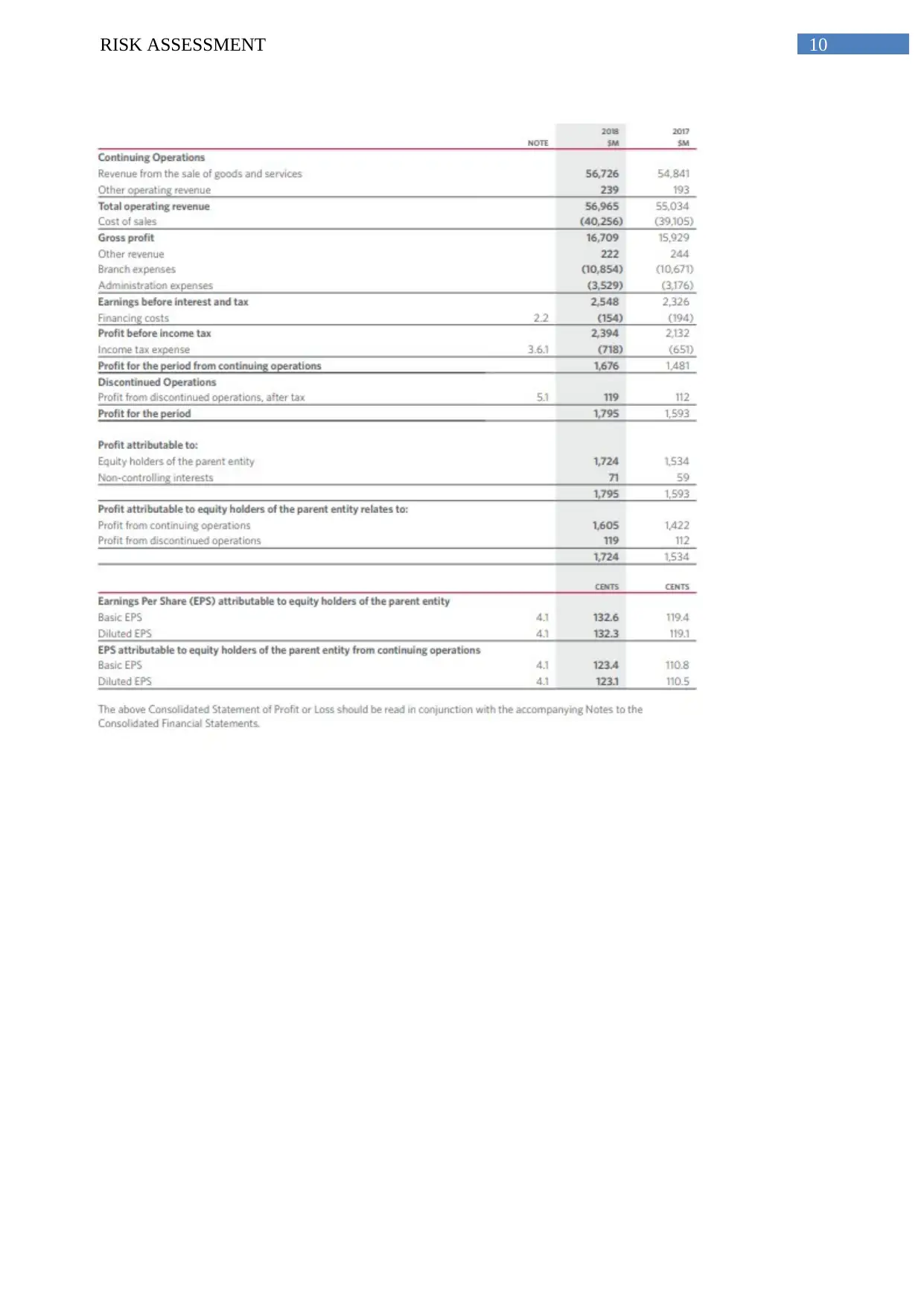
10RISK ASSESSMENT
1 out of 11
Related Documents
Your All-in-One AI-Powered Toolkit for Academic Success.
+13062052269
info@desklib.com
Available 24*7 on WhatsApp / Email
![[object Object]](/_next/static/media/star-bottom.7253800d.svg)
Unlock your academic potential
Copyright © 2020–2025 A2Z Services. All Rights Reserved. Developed and managed by ZUCOL.





